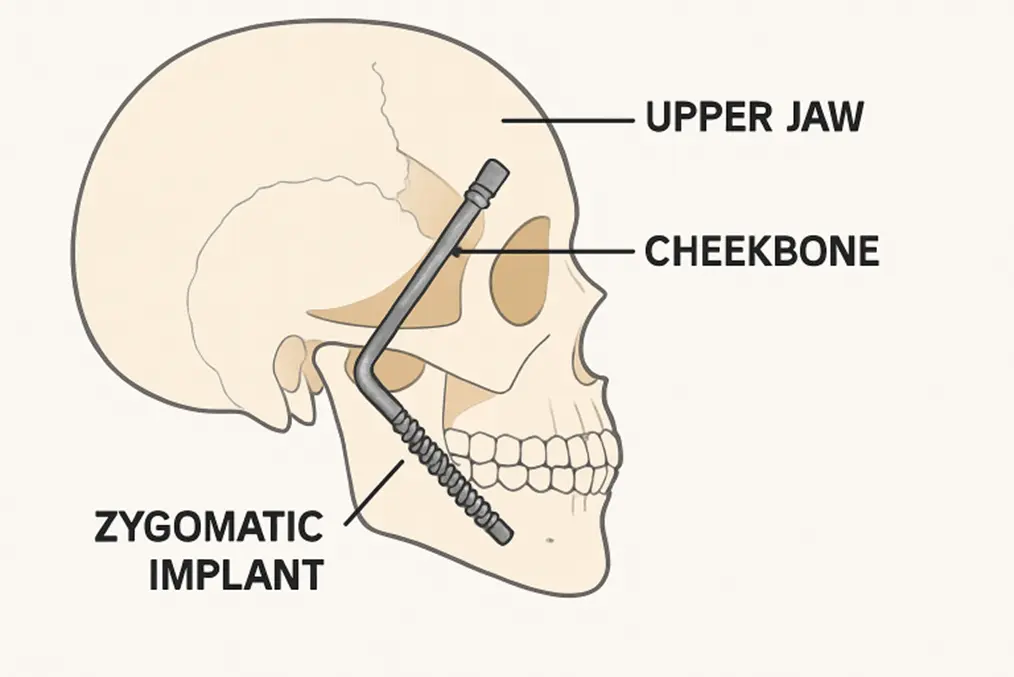Introduction
For many patients experiencing severe bone loss in the upper jaw, traditional dental implants may not be possible without complex and lengthy bone grafting procedures. In these situations, zygomatic dental implants provide a highly effective alternative by utilizing the dense zygomatic bone for enhanced support, minimizing the need for bone augmentation.
This innovative approach allows individuals who would otherwise be ineligible for dental implants to regain normal oral function and aesthetics. By eliminating the limitations of significant maxillary atrophy, zygomatic implants restore confidence and quality of life for patients who previously had few restorative options.
This guide explains these specialized implants’ unique characteristics and clinical applications, including how they differ from standard dental techniques and the impact of recent advancements. Informed patient choice remains central to successful treatment, so understanding the procedure’s benefits, risks, and aftercare is essential for optimal outcomes.
With the growing prevalence of advanced implant dentistry, zygomatic implants stand at the forefront of reconstructive oral surgery, offering hope to those facing the most demanding dental challenges.
What Are Zygomatic Dental Implants?
Zygomatic dental implants are specialized, extra-long implants that penetrate the upper jaw and anchor into the dense zygomatic (cheek) bone. This approach bypasses areas in the maxilla with insufficient bone volume, which is often the result of advanced periodontal disease, trauma, or previous tumor resection. Unlike conventional implants—typically embedded directly into the maxillary ridge—zygomatic implants provide predictable stability in cases where significant bone resorption has occurred, reducing the need for multiple surgeries or waiting periods for bone graft integration.
Indications for Zygomatic Implants
These implants are most often recommended for patients who present with:
- Severe maxillary atrophy, where the natural bone is too thin for conventional implants
- Failed previous bone grafts, eliminating the need for further grafting attempts
- Reconstructed upper jaws following tumor removal or traumatic injury
- High-priority cases where rapid restoration of oral function is medically or psychologically important
Surgical Techniques and Advancements
Ongoing innovation in oral surgery has significantly improved the safety and predictability of zygomatic implant placement. The Zygoma Anatomy-Guided Approach (ZAGA) personalizes treatment, considering each individual’s unique anatomical structure to minimize complications. 3D imaging and custom-printed surgical guides, such as titanium double-sleeve models, enhance precision by directing implant placement along the safest and most stable trajectory. This technology has contributed to greater surgical accuracy, faster recovery, and reduced risk of nerve or sinus complications. A recent technique report discusses these new digital guide systems, marking a leap forward in procedural confidence.
Additionally, immediate loading protocols—where prosthetic teeth are affixed the same day or shortly after implant placement—are now possible due to improved primary stability, further streamlining treatment schedules for qualifying patients.
Benefits of Zygomatic Implants
The adoption of zygomatic implants brings several clear advantages:
- Enables dental rehabilitation in patients with severe maxillary bone loss
- Immediate placement and loading of prosthetic teeth are often possible
- Shorter overall treatment times compared to staged bone grafts
- Survival rates exceed 95% at 12-year follow-up, according to clinical studies
- Restoration of aesthetics and oral function, improving speech, chewing, and confidence
These benefits have made zygomatic implants a life-changing solution for patients deemed ineligible for traditional implant procedures.
Potential Risks and Complications
Although zygomatic implants demonstrate consistently high success rates, patients should understand that certain risks still exist. Because these implants are anchored near the maxillary sinus, sinusitis can occur if inflammation or infection develops. In some cases, nerve involvement may lead to paresthesia—temporary or persistent numbness and tingling sensations. Rarely, implant failure may result from inadequate osseointegration, where the implant does not properly bond with the bone. However, these risks can be significantly reduced with meticulous surgical planning, including 3D imaging and digital mapping. Proper patient education and follow-up care remain essential for safety.
Patient Selection and Preoperative Considerations
Successful zygomatic implant outcomes hinge on careful patient selection. Comprehensive clinical and radiographic evaluation—such as CBCT scans—determines bone anatomy and identifies anatomical limitations. Reviewing medical history, systemic conditions, and patient expectations ensures implant therapy is safe and aligned with desired results. Candidacy may be limited by chronic sinus disease, severe systemic illness, or a history of radiation therapy to the jaw region.
Postoperative Care and Maintenance
Proper postoperative management is fundamental to long-term success. This protocol typically includes antibiotic prophylaxis to prevent infection, pain control, anti-inflammatory medications, and scheduled follow-ups for monitoring healing and integration. Patients must commit to meticulous oral hygiene and routine dental visits to sustain healthy tissue around their implants and extend prosthetic longevity. Long-term maintenance—combined with patient education on oral care—dramatically reduces the likelihood of complications.
Conclusion
Zygomatic dental implants have revolutionized the treatment of patients with severe upper jaw bone loss, particularly those not candidates for traditional implants or bone grafting. By anchoring directly into the zygomatic (cheek) bone, these implants provide exceptional stability, immediate functionality, and long-lasting results. Advancements in imaging technology, digital planning, and customized surgical techniques have enhanced precision, safety, and patient outcomes. Beyond restoring oral function, zygomatic implants help patients regain confidence, facial structure, and overall quality of life. As innovation continues, this approach will remain an essential, life-changing solution in modern restorative and reconstructive dentistry.
Also Read-Health Economics Outcomes Research Shaping Decision-Making in Healthcare
